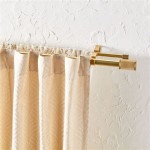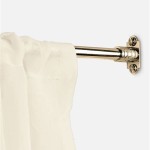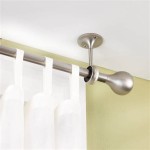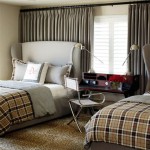Curtain Ideas For Corner Windows
Corner windows, a popular architectural feature, offer expansive views and increased natural light, enhancing the aesthetic appeal of a space. However, their unique configuration poses specific challenges when it comes to window treatments. Selecting the appropriate curtains for corner windows requires careful consideration of functionality, aesthetics, and installation methods. This article explores various curtain ideas tailored for corner windows, examining their pros, cons, and suitability for different design styles.
The primary challenge with corner windows lies in the seamless transition between the two window panes. Traditional curtain rods, designed for straight runs, are often unsuitable. The goal is to achieve a visually cohesive look that effectively controls light, provides privacy, and complements the existing décor. This necessitates specialized hardware and strategic curtain arrangements.
Curved Curtain Rods and Continuous Drapery
One of the most common and effective solutions for corner windows involves employing curved curtain rods. These rods are designed to seamlessly connect at the corner, creating a smooth, unbroken line for the curtains to traverse. The curvature allows the curtains to be drawn across both windows without obstruction, ensuring complete coverage and light control.
Curved rods are available in various materials, including metal, wood, and PVC, each offering different levels of durability and aesthetic appeal. Metal rods, particularly those made from steel or wrought iron, are highly durable and can support heavier fabrics. Wood rods offer a warmer, more traditional look, while PVC rods are lightweight and suitable for lighter curtain fabrics.
When using curved rods, it's crucial to select the correct diameter to ensure the rod can bear the weight of the chosen curtains. Larger diameter rods are generally recommended for heavier fabrics, such as velvet or blackout curtains. Also, the curve of the rod should closely match the angle of the corner window to maintain a smooth and visually appealing transition.
Continuous drapery refers to a single panel of fabric that spans the entire corner window. This creates a uniform and elegant look, minimizing visual breaks and maximizing light blockage. To achieve this, the curtain panel must be wide enough to cover both windows completely when drawn. The fullness of the drapery should also be considered, as more fullness creates a richer, more luxurious appearance but requires more fabric and can obstruct more of the window when open.
Fabric selection plays a significant role in the overall success of continuous drapery. Lightweight fabrics, such as linen or voile, allow some light to filter through even when closed, creating a soft and airy ambiance. Heavier fabrics, such as velvet or blackout lining, provide maximum light control and privacy. The color and pattern of the fabric should complement the existing décor and enhance the overall aesthetic of the room.
Installation of curved rods requires precise measurements and careful alignment. It is recommended to hire a professional installer to ensure the rods are securely mounted and the curtains hang properly. Improper installation can lead to sagging, uneven draping, and potential damage to the walls or windows.
Compared to other options, curved curtain rods offer a versatile and aesthetically pleasing solution for corner windows. They provide a seamless transition, effective light control, and a wide range of design possibilities. However, the cost of curved rods and professional installation can be higher than other alternatives.
Separate Curtain Panels with Corner Connectors
An alternative approach involves using separate curtain panels for each window pane, connected by a specialized corner connector. This method allows for greater flexibility in terms of curtain style and fabric selection, as each panel can be customized independently. It also simplifies installation and maintenance compared to curved rods.
Corner connectors are available in various designs, ranging from simple brackets to ornate finials. The choice of connector depends on the desired aesthetic and the weight of the curtains. Simple brackets provide a minimalist look, while ornate finials add a touch of elegance and sophistication. The material of the connector should match the material of the curtain rods for a cohesive appearance.
When using separate curtain panels, it's important to ensure that the panels align properly at the corner. This can be achieved by precisely measuring the width of each window pane and selecting curtain panels that are slightly wider than necessary. The excess fabric can then be adjusted to create a uniform and balanced look.
The use of tiebacks or holdbacks can further enhance the appearance of separate curtain panels. Tiebacks are used to gather the curtains to the side, allowing more light to enter the room and showcasing the window. Holdbacks are similar to tiebacks but are mounted directly to the wall, providing a more permanent and structured look.
One advantage of using separate curtain panels is the ability to mix and match different fabrics and patterns. This allows for greater creativity and personalization in the design process. For example, one panel could feature a bold pattern, while the other could be a solid color that complements the pattern. This approach can add visual interest and create a unique and dynamic look.
Compared to curved curtain rods, separate curtain panels with corner connectors offer a more flexible and cost-effective solution. They are easier to install and maintain, and they allow for greater customization. However, they may not provide the same seamless transition as curved rods, and the gap between the panels at the corner may allow some light to enter the room.
Layered Window Treatments
Layered window treatments involve combining multiple types of curtains or window coverings to achieve a specific aesthetic or functional goal. This approach is particularly well-suited for corner windows, as it allows for greater control over light, privacy, and insulation. Layered treatments can also add depth and texture to a room, enhancing its overall visual appeal.
A common layering strategy involves combining sheer curtains with blackout curtains. The sheer curtains provide a soft and diffused light during the day, while the blackout curtains offer complete privacy and light control at night. This combination allows for maximum flexibility and versatility.
Another popular layering technique involves combining curtains with blinds or shades. Blinds or shades can be used to control light and privacy during the day, while curtains can be added for insulation and aesthetic appeal. This approach is particularly useful in rooms that require both functional and decorative window treatments.
When layering window treatments, it's important to consider the color, texture, and pattern of each layer. The layers should complement each other and create a cohesive and balanced look. It's also important to ensure that the hardware is compatible with the weight and thickness of the layers.
For example, one could use roller shades for light control and then add decorative curtain panels to soften the look and add visual interest. The roller shades can be retracted completely to maximize the view during the day, while the curtain panels can be closed at night for privacy and insulation.
Another layering option involves combining valances or cornices with curtains. Valances and cornices are decorative window toppers that can add a touch of elegance and sophistication to a room. They can be used to conceal curtain hardware or to add visual height to the windows. They can also be used to introduce a different color or pattern to the room, creating a more dynamic and interesting look.
Layered window treatments can be more expensive and require more installation effort than single-layer treatments. However, they offer a wide range of benefits, including improved light control, privacy, insulation, and aesthetic appeal. They are a particularly good choice for corner windows, as they allow for greater flexibility and customization.
The choice of curtain ideas for corner windows ultimately depends on individual preferences, budget constraints, and the specific needs of the space. Careful consideration of the factors discussed in this article can help homeowners select the most appropriate and effective window treatments for their corner windows.

Corner Window Curtains Solutions Ideas The Shade

How To Hang Curtains On Corner Windows

How To Hang Curtains On Corner Windows

The Perfect Window Covering For Your Corner Dollar Curtains Blinds

Corner Window Curtains Solutions Ideas The Shade

8 Best Curtains For Corner Windows Ideas Window Treatments

How To Make A Great First Impression With Your Home Decor

Living Room Corner Windows Design Ideas

Corner Window Treatments Rustic Bedroom New York By All About Interiors Llc

Corner Window Curtains Solutions Ideas The Shade








